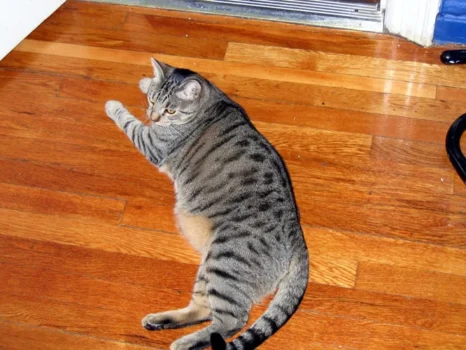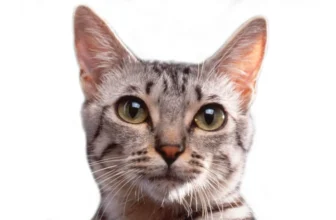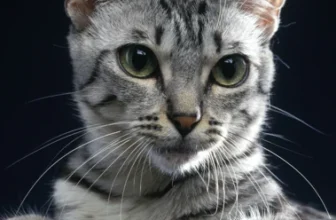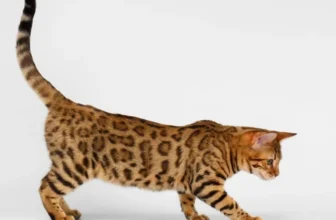If you’re a cat lover who’s considering getting a new feline friend, have you heard about the California Spangled cat breed? These unique cats have a fascinating backstory, a list of desired traits, and even ethical considerations surrounding their breeding. But as with any purebred animal, understanding the role of genetics in their creation is crucial. What are the dominant and recessive genes that determine a California Spangled cat’s appearance and health? What are the risks of breeding them improperly, and how can you ensure responsible breeding practices? In this article, we’ll take a dive into the world of California Spangled cat breeding and explore the ins and outs of their genetic makeup.
The Ins and Outs of Genetics
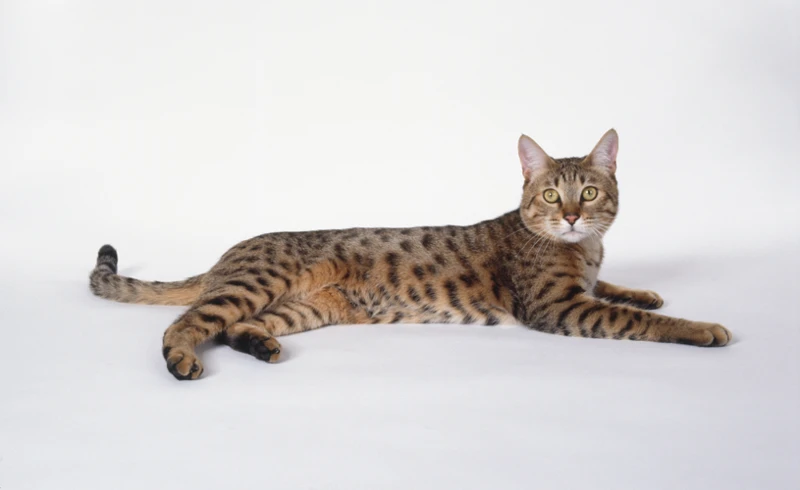
Have you ever wondered why some California Spangled Cats have a certain coat pattern or eye color? The answer lies in the world of genetics. Genetics is the study of inherited traits and how they are passed down through generations. Understanding the role of genetics is important for anyone interested in breeding California Spangled Cats. In this section, we’ll explore the complexity of genetics, including genetic inheritance, diversity, mutation, and disorders. By the end of this article, you will have a better understanding of how genetics plays a crucial role in California Spangled Cat breeding.
Genetic Inheritance
The study of genetic inheritance is crucial for breeders of California Spangled cats. Genetic inheritance refers to the passing of genetic traits from one generation to the next. Cats have 19 pairs of chromosomes which contain genes that determine physical and behavioral characteristics. Each parent provides one set of chromosomes to their offspring, resulting in the kitten having two sets of chromosomes, one from each parent. This process of genetic inheritance can lead to a wide range of outcomes in terms of physical appearance, temperament, and health.
There are different types of inheritance patterns that breeders should be aware of. One is dominant inheritance, where only one copy of a gene is needed for a certain trait to be expressed. For example, if a California Spangled cat inherits one dominant gene for a certain fur pattern, that pattern will be expressed even if the other copy of the gene is different. An example of this is the marbled fur pattern in California Spangled cats, which is caused by a dominant gene. If a kitten inherits one copy of the gene from one parent, it will have the marbled pattern.
On the other hand, recessive inheritance occurs when an individual must inherit two copies of a gene (one from each parent) to express a certain trait. An example of this is the long fur trait in California Spangled cats, which is caused by a recessive gene. If both parents carry one copy of the recessive gene, there is a 25% chance that their offspring will inherit two copies of the gene and have long fur.
To keep track of which genes are being passed on from one generation to the next, breeders use Punnett squares. Punnett squares are a visual representation of the possible combinations of genes that can be inherited from parents. By understanding the different inheritance patterns, breeders can predict what traits their kittens will have and make informed decisions when choosing which cats to mate.
For more information about California Spangled cat breeding genetics, check out our California Spangled Cat Mating Guide.
Genetic Diversity
Genetic diversity refers to the variability found within a species as a result of genetic mutations, genetic recombination, and gene flow. This variability allows for adaptation to changing environments and reduces the likelihood of inbreeding depression. In California Spangled cat breeding, genetic diversity is essential for maintaining a healthy and robust population.
One of the ways to measure genetic diversity is through the use of a tool called a heterozygosity index. Heterozygosity refers to the percentage of genes that differ between a pair of alleles in an individual. A high heterozygosity index indicates greater genetic diversity within a population. California Spangled cat breeders can use this tool to track the genetic diversity of their breeding program and make informed decisions about which cats to breed.
Inbreeding is one of the main threats to genetic diversity. It occurs when closely related individuals mate and produce offspring that carry identical or very similar genetic material. Inbreeding can lead to a reduced genetic diversity, increased likelihood of genetic disorders, and decreased fitness of the offspring. California Spangled cat breeders should avoid mating closely related cats and should strive to maintain a healthy level of genetic diversity within their breeding program.
Another way that genetic diversity is achieved is through outcrossing. Outcrossing refers to the breeding of a cat from one breed with a cat from another breed. This can introduce new genetic variation into the gene pool. However, it is important to ensure that the outcross cat is healthy and free from genetic disorders that could be introduced into the California Spangled cat population.
Genetic diversity is essential for the long-term health and sustainability of the California Spangled cat breed. Breeders should be attentive to the heterozygosity index of their breeding program and strive to maintain a high level of genetic diversity. Additionally, the avoidance of inbreeding and the careful use of outcrossing can help to maintain this critical aspect of the breed.
For more information on preparing for California Spangled cat breeding, check out our article on preparing California Spangled cat breeding: tips and tricks.
Genetic Mutation
The Role of Genetic Mutation in California Spangled Cat Breeding
Genetic mutation refers to a sudden change in the DNA sequence that can lead to altered genetic traits in offspring. These mutations can either be beneficial or harmful, and they can occur randomly or as a result of external factors such as radiation or certain chemicals.
In California Spangled Cat breeding, genetic mutation plays a crucial role in the development of new and desirable traits in the breed. Breeders carefully select cats that possess certain mutations that will enhance their physical attributes and overall health.
One of the most notable mutations in California Spangled Cats is the “spangle” pattern, which is the result of a genetic mutation that occurred naturally in a rescue cat named “Autumn Dawn,” who became the first California Spangled Cat. The spangle pattern is a distinctive look that sets the breed apart from others and has become a sought-after trait in breeding programs.
Another desirable mutation in California Spangled Cats is the “marble” pattern. This pattern is created by a different mutation than the spangle pattern and resembles the coat of a wildcat. Many breeders aim to produce California Spangled Cats with this unique and attractive coat pattern.
It is important to note that while genetic mutation can be beneficial in breeding programs, it can also lead to genetic disorders. Breeders must be careful to avoid breeding cats with harmful mutations that can impact the health and well-being of their offspring.
Additionally, mutations can occur randomly and unpredictably in breeding programs, leading to the development of unintended genetic traits. Breeders must monitor their breeding programs closely to ensure that mutations that arise do not negatively impact the breed.
Genetic mutation plays a vital role in California Spangled Cat breeding. Breeders carefully select cats with desirable mutations that will enhance the breed’s physical attributes and overall health, while avoiding harmful mutations that can lead to genetic disorders. The aim of mutation in California Spangled Cat breeding is to create cats with unique and attractive physical attributes that also have sound genetic health.
Genetic Disorders
Genetic disorders refer to inherited conditions that affect an animal’s physical or mental health. In the case of California Spangled Cats, these disorders can be passed down from generation to generation if left unchecked. In fact, there are several genetic disorders that breeders must be aware of to ensure the health and wellbeing of their cats.
One of the most common genetic disorders in California Spangled Cats is Progressive Retinal Atrophy (PRA). This condition involves the gradual deterioration of the retina, which can lead to blindness if left untreated. PRA is caused by a mutation in one of the cat’s genes, and as such, it is a hereditary condition.
Another genetic disorder that affects California Spangled Cats is Hypertrophic Cardiomyopathy (HCM). This disorder causes thickening of the heart muscles, which can lead to heart failure if left untreated. HCM is caused by a genetic mutation that is passed down through breeding.
Additionally, Polycystic Kidney Disease (PKD) is also a genetic disorder that can affect California Spangled Cats. This condition involves the formation of cysts on the kidneys, which can lead to kidney failure if left untreated. PKD is caused by a genetic mutation that is also hereditary.
To prevent genetic disorders from being passed down to future generations, breeders must screen their cats for such conditions before breeding. Additionally, avoiding inbreeding and promoting genetic diversity can also help reduce the incidence of genetic disorders in California Spangled Cats.
It’s important for breeders to prioritize the health and wellbeing of their cats above all else. By staying informed about common genetic disorders and taking steps to prevent them from being passed down, breeders can help ensure that their cats live long, healthy lives.
Link: /optimal-breeding-age-california-spangled-cat/
Breeding California Spangled Cats
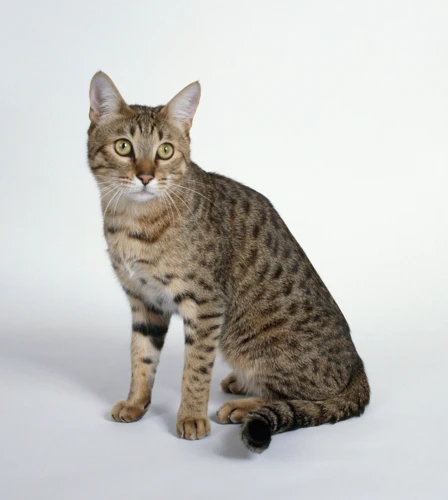
Breeding California Spangled cats entails more than just putting two cats together and hoping for the best. It requires detailed knowledge of genetics and an understanding of the particular traits that make the California Spangled breed unique. If you’re considering breeding California Spangled cats, it’s important to be aware of the history of California Spangled cat breeding, the desired traits in these cats, and the various considerations that come into play, such as domestic vs. wild cat breeding. Let’s dive deeper into what it takes to breed healthy and happy California Spangled cats.
History of California Spangled Cat Breeding
California Spangled cats are a unique breed created by Paul Casey in the 1980s. He was inspired by the beauty and grace of wild cats, such as leopards and ocelots, and wanted to create a domestic cat that resembled these stunning animals.
Casey began his breeding program by selecting cats with desirable traits, such as athleticism, grace, and striking coat patterns. He also wanted to ensure that his cats were healthy and free of any genetic disorders that could be passed on to future generations.
To achieve his goal of creating a domestic cat with wild features, Casey crossed several different breeds, including Siamese, Persian, Abyssinian, and American Shorthair. The crossbreeding program was not without its challenges, but Casey persisted in his efforts, and eventually the California Spangled cat was born.
The California Spangled cat quickly gained popularity among cat enthusiasts and was even featured in advertising campaigns for brands such as Chrysler, Coca-Cola, and Bloomingdale’s. However, despite their initial success, the breed faced a decline in popularity in the 1990s due to competition from other domestic cat breeds and concerns over their perceived “wild” nature.
Today, the California Spangled cat is still a rare breed, but it is slowly making a comeback thanks to the efforts of dedicated breeders who are committed to preserving this unique and beautiful cat.
If you are interested in breeding California Spangled cats, it is important to understand the breed’s history and the traits that make them so special. By studying the breed’s origins and characteristics, you can create a successful breeding program that produces healthy, happy cats with the stunning coat patterns and athletic abilities that these cats are known for.
If you want to learn more about the breeding process, check out our articles on successful mating and birthing of California Spangled cats, as well as tips on dealing with infertility issues that can arise during breeding.
Desired traits in California Spangled Cats
Breeding California Spangled Cats requires an understanding of the desired traits that make up the breed. These traits are important because they help maintain the breed’s unique appearance and temperament.
The California Spangled Cat is a medium-to-large-sized, muscular cat with a short, glossy coat. The breed has a distinctive wild appearance, with spots and stripes similar to that of a wild leopard or ocelot. In addition to their striking appearance, California Spangled Cats are known for their playful, curious, and affectionate personalities. These traits are highly desirable and sought after in the breed.
Physical Traits
The physical traits of California Spangled Cats should adhere to strict guidelines. The Cat Fanciers’ Association (CFA) has established standards for the breed that include the following physical traits:
| Physical Traits | Description |
|---|---|
| Body | Medium to large, muscular body |
| Coat | Short, tightly glossy coat with spots and stripes |
| Head | Small to medium-sized head with rounded contours. Muzzle should be short, padded, and well-developed, with a lifted chin. Nose should be broad and have a slight curve. |
| Eyes | Large, almond-shaped, and set wide apart. Eye color should be gold, green, or hazel. |
| Ears | Medium in size, with slightly rounded tips. |
| Tail | Medium in length, tapered at the end, and thick at the base. |
Temperament Traits
Aside from their physically unique appearance, the California Spangled Cat is known for its friendly and social temperament. They are playful, intelligent, and very curious, making them great companions for both children and adults. California Spangled Cats are also active and agile, often displaying impressive athleticism.
Breeding cats with desirable temperament traits can be just as important as physical traits. California Spangled Cats should be social, confident, and curious. They should be friendly and affectionate, but not excessively clingy. It is also important to breed cats that are easily trained, as they can be taught tricks and behaviors that make them even more endearing to their owners.
Conclusion
Breeding California Spangled Cats requires careful consideration of both physical and temperament traits. While physical traits help define the breed’s distinctive wild appearance, temperament traits are equally important for creating friendly and social cats that make wonderful companions. Breeding cats with these desirable traits will maintain the breed’s unique appearance and temperament for generations to come.
Considerations when Breeding
When it comes to breeding California Spangled cats, there are several essential considerations that breeders need to keep in mind. These considerations are important to ensure that the breeding process is successful, and that the kittens born are healthy, happy, and have the desirable traits that are expected of the breed.
Breeding Goals: Before beginning the breeding process, it’s important to have clear breeding goals in mind. This includes having a good understanding of the breed standards, the desired traits, and characteristics that are important for the California Spangled cat. Breeders should also have an idea of how many kittens they want to produce, and what they plan to do with them.
Genetic Testing: Genetic testing is crucial before breeding any cat. Testing can reveal any genetic disorders or vulnerabilities that the cat may have, and this information can be used to inform breeding decisions. Breeders also need to carry out testing to identify carriers of genetic disorders and remove them from the breeding pool.
Health: Health checks are another important consideration when breeding California Spangled cats. Breeders need to ensure that the cats they breed are in good health and free from any diseases or illnesses that could be passed down to kittens.
Mating: When it comes to mating, breeders need to be very careful to ensure that they pair cats that are compatible and have the desired traits. Breeders should also consider if they want to mate with an outcross, which is breeding with a cat from another breed, or an inbreeding program, which is breeding within the same family.
Environmental Concerns: Breeding cats in a stable and nurturing environment is pivotal to the success of the breeding process. Breeders should keep cats in a clean and safe environment, and provide them with enough space and food to live comfortably. It’s also important to avoid overcrowding.
These considerations may seem like quite a handful, but they are essential to the breeding process. It takes a lot of hard work and dedication to be a responsible breeder. However, the rewards are tremendous, both in terms of the kittens produced and the positive impact that the breeder can have on the California Spangled breed.
Domestic vs. Wild Cat Breeding
Breeding California Spangled cats can involve either domestic or wild cat breeding. Domestic cat breeding involves breeding cats of the same breed together to produce offspring with desired traits. This is the most common form of cat breeding and is generally considered safe and ethical as long as responsible breeding practices are followed.
Wild cat breeding, on the other hand, involves breeding domestic cats with wild cats, such as the Asian leopard cat, to produce hybrids. The purpose of hybrid breeding is usually to produce cats with unique and desirable physical traits, such as the California Spangled cat’s wild appearance.
However, domestic cat breeding is generally considered more ethical and safe than wild cat breeding. This is because:
- Wild cat hybrids can exhibit unpredictable behavior and may not make ideal pets for the average cat owner.
- Wild cat hybrids may also have unique health problems due to their mixed genetics, making them more difficult to care for.
- Wild cat hybrids can present a risk to the wild cat population if they are not sterile, as they could potentially mate with wild cats and create further hybrids, diluting the gene pool of the wild species.
It is important for breeders to carefully consider the ethics and safety of their breeding practices before attempting to produce wild cat hybrids. They should also ensure that they are following all legal requirements for breeding and licensing of these animals, as they may be subject to stricter regulations than domestic cats. While the unique appearance of wild cat hybrids may be appealing, it is important for breeders to prioritize the welfare and safety of both the cats and the wider feline population.
Ethics of California Spangled Cat Breeding
When it comes to breeding any type of animal, ethical considerations are of utmost importance. Breeding California Spangled cats is no exception. It is crucial to evaluate the ethical implications of breeding these cats, especially considering the history and rarity of the breed. Breeding practices that prioritize animal welfare should be embraced, while those that prioritize profit over the well-being of the cats should be avoided. In this section, we will explore the ethical considerations that come with breeding California Spangled cats, including animal welfare concerns, breeding practices to avoid, and responsible breeding practices.
Animal Welfare Concerns
The ethics of breeding and selling California Spangled Cats has long been a topic of debate, with a significant emphasis placed on the welfare of the animals involved. It is essential to understand and address any potential concerns related to this topic to ensure that ethical breeding practices are observed. Here are some of the most important animal welfare concerns regarding California Spangled Cat breeding:
| Concerns | Description |
|---|---|
| Overbreeding | Overbreeding can cause health problems for the cats and lead to overpopulation, with many cats ending up in shelters or abandoned. |
| Genetic Disorders | Some breeding practices may increase the risk of genetic disorders in cats, which can cause severe health complications. |
| Stress | Breeding and raising cats in confined spaces or in uncomfortable conditions can cause them significant amounts of stress, which can lead to health issues. |
| Unwanted Cats | If breeders produce more cats than they can sell, the unwanted cats may end up in shelters or abandoned, where they may face illness or even death. |
These are just some examples of animal welfare concerns that arise when breeding California Spangled Cats. Responsible breeders take steps to ensure that such concerns are addressed. They prioritize the health and well-being of their cats while also maintaining the desired traits that are essential to the breed.
Breeding Practices to Avoid
When breeding California Spangled cats, it is important to be aware of the breeding practices that should be avoided. These practices can lead to genetic mutations and health problems in the cats, and can also raise ethical concerns.
Here are some breeding practices to avoid:
| Breeding Practice | Explanation |
|---|---|
| Inbreeding | Inbreeding involves mating closely related cats, such as siblings or parent-offspring pairs. This can lead to a lack of genetic diversity, which increases the likelihood of inherited health problems and decreases the cats’ overall fitness. |
| Linebreeding | Linebreeding is a less extreme form of inbreeding, where cats are mated with more distant relatives. While this can help maintain desirable traits in a bloodline, it can still lead to a reduction in genetic diversity and the risks associated with inbreeding. |
| Overbreeding | Breeding cats too frequently can lead to physical and emotional stress on both the mother cat and her offspring. It can also lead to a surge in the population of cats, which can result in overcrowding and overburdening of our shelters and rescue organizations. |
| Force-breeding | Force-breeding involves using artificial insemination or other methods to mate cats who would not naturally breed. This can lead to physical injuries and stress for the cats, as well as genetic defects or abnormalities in the offspring. |
| Intentional breeding for genetic abnormalities | Some breeders may intentionally mate cats with certain genetic abnormalities, such as extra toes or hairless coats, to produce more kittens with those traits. While some of these traits may not pose health risks to the cats, it can still be seen as unethical to purposely breed cats with abnormalities for the sake of novelty. |
By avoiding these breeding practices, breeders can help ensure the health and well-being of California Spangled cats, as well as maintain ethical standards in cat breeding.
Responsible Breeding Practices
When it comes to breeding California Spangled cats, it is important to prioritize responsible breeding practices. This not only ensures the health and well-being of the cats themselves, but also helps to maintain the characteristics and genetic diversity of the breed.
One responsible breeding practice is to carefully assess the health of the cats before breeding them. This includes genetic testing to screen for any potential health issues, as well as ensuring that the cats are up-to-date on their vaccinations and free of any parasites or infections. It is also important to consider the age of the cats, as breeding too young or too old can increase the risk of complications.
Another important aspect of responsible breeding is properly socializing the kittens. This helps to ensure that they are comfortable with human interaction and that they will be well-adjusted in their new homes. This can include introducing them to different people, sounds, and smells in a safe and controlled environment.
Additionally, responsible breeders will carefully select compatible pairs of cats for breeding in order to ensure that their offspring will have the desired traits and characteristics. This can involve studying their pedigrees and analyzing their genetic makeup to ensure that they are not too closely related and that they do not share any common genetic disorders.
It is also crucial for breeders to establish open and honest communication with potential cat owners. This means being transparent about any health or behavioral issues that the cat may have, as well as providing guidance on appropriate care and socialization.
By following responsible breeding practices, breeders can help to ensure the well-being of the cats and maintain the genetic diversity of the California Spangled cat breed.
Table:
| Responsible Breeding Practices | Description |
|---|---|
| Careful Health Assessment | Genetic testing, vaccinations, parasite screenings |
| Socialization | Introducing kittens to different people, sounds, and smells in a safe and controlled environment |
| Pair Selection | Studying pedigrees, analyzing genetic makeup, avoiding closely related cats and those with common genetic disorders |
| Effective Communication | Being transparent about health and behavioral issues, providing guidance on appropriate care and socialization |
Conclusion
In conclusion, breeding California Spangled cats involves a thorough understanding of genetics and the implementation of responsible breeding practices. It is crucial to consider the ethics of breeding and prioritize animal welfare concerns. A breeder must strive to maintain genetic diversity and minimize the risk of genetic disorders through proper breeding selection. Desired traits must also be carefully considered in order to produce healthy and desirable California Spangled cats.
As with any animal breeding practice, there are risks and ethical concerns that must be taken seriously. It is important to avoid breeding practices that prioritize profits over animal welfare, such as inbreeding or the sale of unfit kittens. Instead, responsible breeding practices involve prioritizing the health and well-being of the cats while breeding for desirable traits.
Ultimately, the role of genetics in California Spangled cat breeding is a complex one, but with the implementation of responsible breeding practices, high-quality and healthy cats can be produced. By prioritizing animal welfare concerns and understanding genetic inheritance, diversity, mutation, and disorders, breeders can work towards creating a sustainable and ethical breeding industry for California Spangled cats.
Frequently Asked Questions
What makes California Spangled Cats unique?
California Spangled Cats are a unique breed known for their striking spotted coat pattern and their natural athleticism.
Can anyone breed California Spangled Cats?
No, only responsible and experienced breeders should attempt to breed California Spangled Cats to ensure the health and well-being of the cats and their offspring.
What genetic disorders should be watched for in California Spangled Cat breeding?
Some genetic disorders that have been observed in California Spangled Cats include hypertrophic cardiomyopathy (HCM) and progressive retinal atrophy (PRA).
What traits should be prioritized when breeding California Spangled Cats?
Traits that should be prioritized include good health, a well-formed body, and a spotted coat pattern that conforms to breed standards.
Can California Spangled Cats be bred with other breeds?
No, it is not recommended to crossbreed California Spangled Cats with other breeds as it can dilute the breed’s unique characteristics and increase the risk of genetic health issues.
What are some ethical concerns surrounding California Spangled Cat breeding?
Some ethical concerns include inbreeding, overbreeding, and using cats solely for profit rather than considering their well-being and future homes.
How can potential owners ensure they are adopting a healthy California Spangled Cat?
Potential owners should do research on the breeder and ask for health clearances for the kitten’s parents. They can also ask for information on the kitten’s diet and living conditions.
What is the history behind California Spangled Cat breeding?
California Spangled Cats were first bred in the 1980s by a woman named Paul Casey, who aimed to create a domestic cat breed with the appearance and wildness of a leopard.
Are California Spangled Cats good pets?
Yes, California Spangled Cats can make good pets for people who are able to meet their needs for exercise, play, and attention.
How can breeders improve genetic diversity in California Spangled Cat breeding?
Breeders can work to improve genetic diversity by using cats from different breeding lines and by not relying exclusively on a small number of popular breeding cats.

